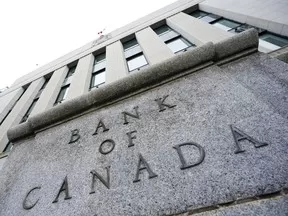Central bank held interest rates at 5% for the sixth consecutive time
Article content
The Bank of Canada kept interest rates at five per cent on Wednesday, its sixth consecutive hold since the last increase in July 2023. Here’s what economists are saying about the decision and whether the bank has opened the door to a rate cut at its next meeting on June 5.
‘Why rush?’: CIBC Economics
Article content
The Bank of Canada “appears to be moving only very slowly towards lowering interest rates,” Andrew Grantham, an economist at Canadian Imperial Bank of Commerce, said in a note on the decision.
Advertisement 2
Article content
Central bank officials acknowledged that progress in being made on core inflation, but want see more data that reinforces the slowdown is sustainable, Grantham said.
The next two inflation reports due out before the bank meets on June 5 hold the “key” to whether the officials decide to cut rates soon, the economist said.
“The fairly neutral tone of the statement shouldn’t be a big surprise as the bank needed to justify why it didn’t start cutting interest rates today,” he said.
‘Leaves door open’: Capital Economics
The clock is ticking down to the first interest rate cut, possibly in June, Capital Economics deputy chief North America economist Stephen Brown said in a note.
“The acknowledgment by the Bank of Canada today that ‘the data since January have increased our confidence that inflation will continue to come down’ leaves the door open to an interest rate cut at the next meeting in June,” Brown said.
Brown said the bank’s statement on core inflation indicates it’s comfortable with how much price pressures have eased and now just needs to see them stay down.
“The bank seems to be open to our forecast of a June rate cut if the month-over-month changes in core prices remain muted for the next couple of months,” Brown said.
Article content
Advertisement 3
Article content
Still, bank officials perceive “risks” to its interest-rate trajectory, especially from the United States where a reacceleration in inflation could cause the Federal Reserve to revert to a more hawkish tone, pushing back rate cuts.
In that case, the Bank of Canada is “unlikely to be in a big rush to cut interest rates — and risk a depreciation of the loonie.”
Four cuts in 2024: Manulife Investment
With the Bank of Canada no longer concerned that inflation is “too high,” Dominique Lapointe, director of macro strategy for Manulife Investment Management, said the company is calling for four interest rate cuts in 2024, starting at the June meeting.
“With two inflation reports coming up before the June 5 decision, we believe more evidence of softer inflation could be gathered,” Lapointe said in an email.
Stronger-than-expected growth in the Canadian economy gives the central bank options on timing the first cut, Lapointe said, however, he expects the job market to show more signs of weakness and GDP to miss the bank’s forecast, strengthening the case for four cuts.
‘Trimming as early as June’: Desjardins
Advertisement 4
Article content
“It looks like the Bank of Canada is ready to begin trimming rates as early as June,” Royce Mendes, an economist at Desjardins Group, said in a note, as long as the next two consumer price index releases due out between now and the next central bank meeting confirm that core inflation is sustainably slowing.
“Overall, policymakers are seeing enough signs in corporate pricing behaviour, inflation expectations and wage growth to conclude that the disinflationary trend can continue even with an increase in expected economic growth this year,” Mendes said.
The Bank of Canada had previously highlighted worries about price increases by companies, elevated inflation expectations among businesses and consumers and rising wage growth.
Mendes also said it’s possible the bank could cut rates to as low as three per cent, after it raised its neutral rate by 25 basis points to a range of between 2.25 per cent and 3.25 per cent. The neutral rate reflects an interest rate that supports a strong economy and maximum employment without causing inflation.
Recommended from Editorial
“The new neutral rate estimate could actually be interpreted as a dovish doubling down that rates are going to fall more than what traders are pricing in,” he said.
The “fly in the ointment,” is U.S. inflation, which accelerated 3.5 per cent in March, “creating some concern that … price pressures could spill over the border.”
• Email: gmvsuhanic@postmedia.com
Bookmark our website and support our journalism: Don’t miss the business news you need to know — add financialpost.com to your bookmarks and sign up for our newsletters here.
Article content
